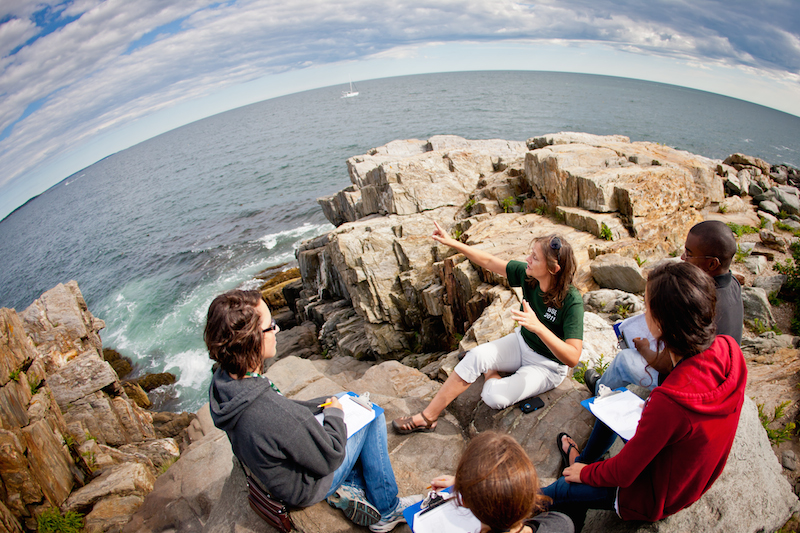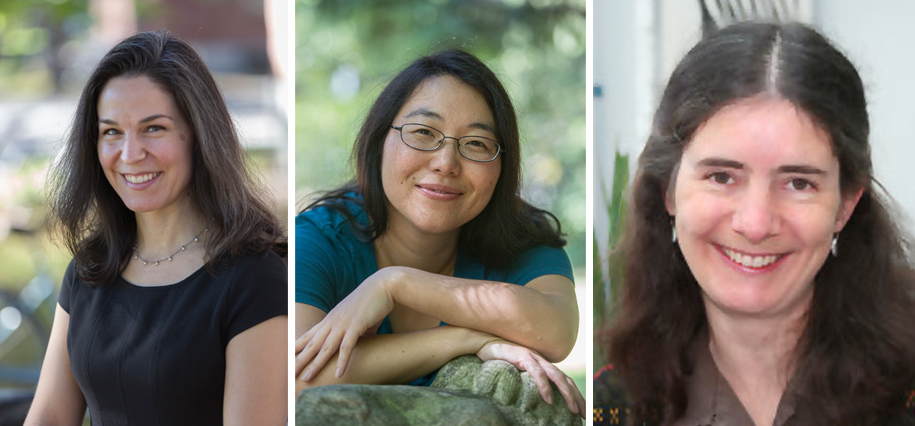The Giant Stairs of Bailey Island: An Evolving Outdoor Classroom
By Rebecca Goldfine
This story was originally published in the Harpswell Anchor.
At the narrow end of Bailey’s Island in Harpswell, a series of dark, blocky stones are laid out one on top of another, like a huge staircase leading down to the sea. Known as the Giant Stairs, they’ve long been a favorite destination for Bowdoin scientists and students because they’re a curious anomaly set within the flaky rust-gray metamorphic rock around them.
The Giant Stairs were formed about 200 million years ago, when the Pangea supercontinent was breaking apart. Molten material flowed up through cracks and fissures in the rock, hardening into basalt and forming this unusual dike.
Faculty from the Earth and Oceanographic Science Department frequently bring introductory and advanced classes to the site to decipher, from clues revealed in the minerals and rocks, just what went on here millions of years ago. “The Giant Stairs are wonderfully exposed and provide a natural laboratory for teaching observation and interpretation skills,” Professor of Earth and Oceanographic Science Rachel Beane said. “The geologic history recorded in this location is astounding and spans from sediments around volcanic islands millions of years ago, through the coming together of Pangaea, and then to the opening of the Atlantic Ocean. Giant Stairs is a treasured coastal location for learning.” Beane also gives public lectures at the Stairs, and has coordinated, with Delger Erdenesanna ’15, an educational program at the spot for fourth graders from Harpswell Community School.
But the site doesn’t just attract people studying the formation of the earth — it is also a compelling area for Bowdoin’s marine biologists and students, who can spend hours observing the diverse life living in the tidal pools and intertidal zone. The community of researchers who visit the Giant Stairs are careful to not damage the habitat.
The Giant Stairs bioblitz
Early in the fall semester, students who are part of Bowdoin’s Marine Science Semester head out to the Giant Stairs for a “bioblitz.” Bioblitzes are an increasingly popular way to gather scientists, students, citizen naturalists or other volunteers to survey all the living species in an area. “It’s a non-invasive way to assess the diversity of organisms in a certain spot,” said Sarah Kingston, who is a visiting assistant professor of biology who teaches Marine Science Semester courses.
As they conduct the survey, the Marine Science Semester students also learn to identify organisms — like algae and invertebrates — living in the intertidal zone. Later in the semester, they will visit several monitoring stations Bowdoin has set up along the coast — at the Coastal Studies Center in Harpswell, and on Hurricane Island and Kent Island — to census the species in the intertidal zones. They do this to “see how the intertidal community is changing over time as water in the Gulf of Maine is changing,” Kingston explained.
The students head out with buckets for the bioblitz, but they don’t keep any of the organisms. “Someone will find something, put it in a bucket with water to transport to show other students, then transfer it back to its original location,” Kingston said. “This is to keep the organism alive and not stress it out.”
Other Bowdoin biologists also occasionally take their classes to the Stairs, including Amy Johnson, Bowdoin’s James R. & Helen Lee Billingsley Professor of Marine Biology. She brings her upper-level marine biology class on two Harpswell field trips per semester. For the first trip, students familiarize themselves with the site’s species — but warned to not disturb the habitat. “The students are lectured before going out into the intertidal that the rocks are the creatures’ homes and so rocks that are turned over are returned to the way they are found,” she said.
The second time they go out, the students measure the salinity, pH, oxygen and temperature of four tidal pools from the high to the low intertidal, as well as count the number of species living in the pools. “We use these data to understand the relationship between the kinds of creatures that are in the tide pools, and the time of day and physical parameters of the tide pools, which helps the students understand why increasing CO2 leads to ocean acidification,” Johnson explained.





A changing habitat
Jonathan Allen, who is an associate professor of biology at William & Mary, regularly visits the Giant Stairs with his students during the summer. He comes to Maine each year to take advantage of the Bowdoin Coastal Studies Center’s wet lab, where he is continuing his investigation into what factors help marine animals successfully transition from juvenile to adulthood.
This summer, a small group of students will spend about 90 minutes at the Giant Stairs at the end of August, according to Matt Gee, assistant director of the McKeen Center for the Common Good.
Later in the semester, however, community-minded students will head to different spots in Harpswell to do volunteer work to celebrate Bowdoin’s annual Common Good Day, on Sept. 16. Five groups will split up to help build a trail at the new Otter Brook Preserve, do yard work around Cundy’s Library, remove barbed wire and clean up Mitchell Field, clear trails at the Coastal Studies
The virus is not new to sea stars, but some researchers believe the organisms are more susceptible to it now because they are stressed by rising water temperatures. The drop in sea stars might also be linked to the decline in the species they most like to eat — blue mussels
“In 2007, 2008, we would snorkel just off the Giant Stairs, not collecting, just censusing, and there were hundreds of quite large, visible sea stars in the tidal range,” Allen said. “Those are almost all gone and no one knows exactly why.”
In many ways — even beyond the scarcity of sea stars — “the Giant Stairs habitat looks different than it did 10 years ago,” Allen said. While some Giant Stairs neighbors have worried that the decline in species is due to Bowdoin students over-collecting sea stars, mussels, urchins, and other organisms, the reality is many marine species are decreasing all along the Gulf of Maine coast.
For instance, sea urchins, once abundant in Maine, were overfished in the 1990s for their gonads, which are considered a delicacy in sushi restaurants.
In fact, the research conducted by Bowdoin students aims to understand how to protect sea stars and other species, and perhaps encourage their return to environments like the waters near the Giant Stairs. When Allen visits the Giant Stairs, he and his students conduct a field survey, flipping over rocks to count the snails, green urchins, crabs, lobsters, and worms living underneath. They use this information to establish realistic conditions in the wet lab for their sea stars, so they can find out what helps or hinders their development from larvae to juveniles to adults.
They also collect tiny, microscopic mussels from algae that grow in the tidal pools as food for their young sea stars. “In one tidal pool, we’re collecting a minuscule percentage,” he said. “It is less than one-tenth of one percent of mussels and algae from one tidal pool.”
Interestingly, some spots in Maine have not seen such a dramatic drop off in sea stars, including in nearby Basin Point in Harpswell. “What is different about one point in Harpswell versus another point? So that is one of the questions we’re asking,” Allen said. “Is there more food for them or fewer predators? Are they more protected from storms? What is different about that site?”
Shellfish adaptability to acidic oceans
Sarah Kingston has also visited the Giant Stairs to gather a few mussels for her genetics research. In a joint effort with Coastal Studies Director David Carlon, she is studying whether sea organisms that build shells can survive the Gulf of Maine’s changing waters. “The ability to form a shell becomes harder when the water becomes more acidic,” she said. “So one of the things I’m looking at with blue mussels is whether the population that lives in the Gulf of Maine has the genetics to cope as the waters warm and get more acidic.”
Two years ago, she collected fewer than 100 mussels from the mussel beds at the rocks around Giant Stairs, which harbor many thousands of mussels. She also collected mussels from different sites along the Maine coast. She then tested their ability to form shells by growing them in wet lab tanks that mimic conditions predicted for seas in 2100.
They discovered that a small percentage of mussels do have a genetically based ability to
Kingston also once collected periwinkles from the Giant Stairs — under 40 from the large population that lives there. Again, she has also collected a small number of snails from different spots along the coast to investigate the genetics underlying shell hardiness and shape, which varies from site to site, possibly based on how much the area is buffeted by waves or the number of crab predators living there.
The experiments that Kingston and Allen are conducting in the lab, in semi-natural environments, will allow them to make predictions about what will happen to marine organisms in the future.



